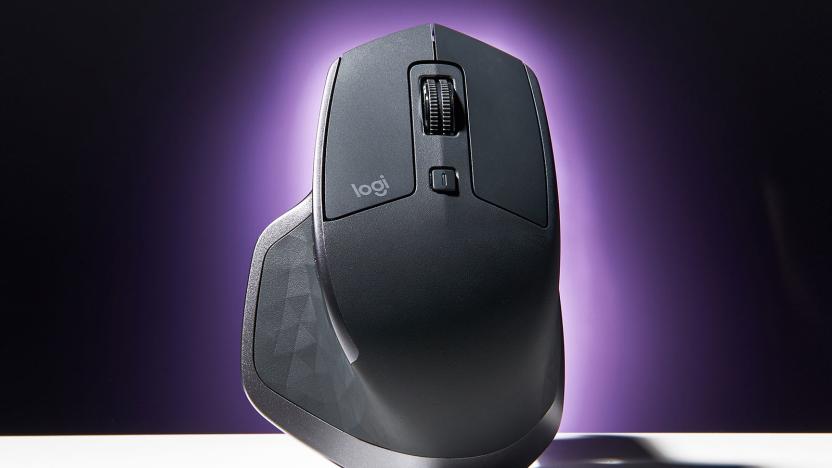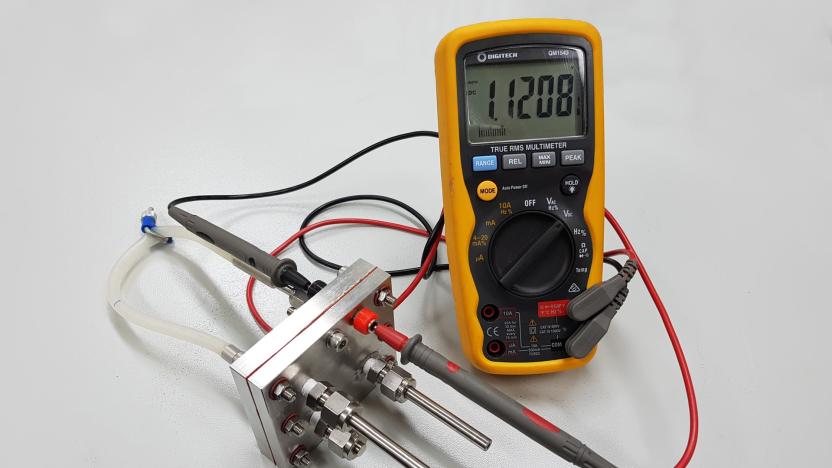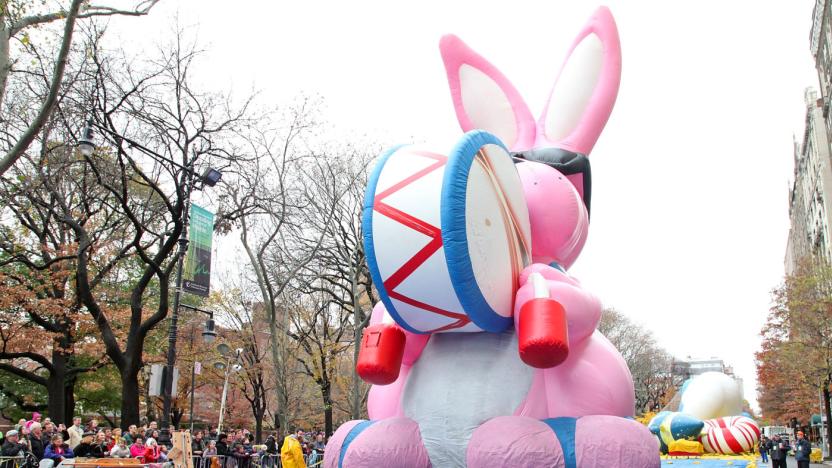rechargeable
Latest

Pioneers of lithium-ion batteries win the 2019 Nobel Prize in Chemistry
This year's Nobel Prize in Chemistry has been awarded to three scientists credited with the invention of the rechargeable lithium-ion battery. John B Goodenough of the University of Texas at Austin, M Stanley Whittingham of Binghamton University and Akira Yoshino of Meijo University will receive equal shares of the 9m Swedish kronor ($905,000) prize, which was announced today by the Royal Swedish Academy of Sciences in Stockholm.

One of the best mice on the market is on sale for $67
The Logitech MX Master 2S is on sale at Amazon for $67 -- that's a $33 drop from its typical list price of $100. The mouse is one of our longtime favorites, and it was listed in our 2017 gift guide. While it's not the newest model, it's still a great mouse and an excellent deal at $67.

Self-charging pacemakers are powered by patients' heartbeats
Millions of people around the world depend on pacemakers, defibrillators and other life-saving implantable devices. The problem is, their batteries need to be replaced every five to ten years, requiring surgery that's not only expensive, but carries the risk of complications and infections. Now, though, a team of scientists are developing an implantable biomedical device that can be recharged with energy from cardiac activity.

'Proton' battery uses cheap carbon instead of lithium
A big challenge for the EV and renewable energy revolution is that the much-needed batteries are made from lithium, a relatively rare and pricey metal. Rather than focusing on other metals like magnesium, a team of scientists from RMIT University in Melbourne have figured it out to build rechargeable "proton" batteries from abundant carbon and water. If commercialized, the technology could allow for cheaper Powerwall-type home or grid storage to back up solar panels or windmills.

Smartphone batteries with twice the life may arrive in 2017
A type of lithium battery that could make gasoline-powered cars obsolete is on track to be commercialized, according to MIT News. The "lithium metal" batteries, developed by MIT spin-off SolidEnergy, can reportedly pack the same energy as a standard lithium-ion cell in half the size. "Or, we can make a battery the same size as a lithium ion battery, but now it will last twice as long," says SolidEnergy CEO Qichao Hu.

Energizer intros rechargeable batteries made from recycled cells
Energizer broke fresh ground when it made the first disposable batteries from recycled cells, but that immediately raised a question: where are the rechargeable versions? As of today, they're here. The company has introduced new Recharge AA and AAA cells that are the first to be made using old batteries. About 4 percent of their material comes from used power packs, including those from hybrid cars -- yes, the leftovers from your Prius could one day power a kid's toy.

Stanford's aluminum battery fully charges in just one minute
Lithium-ion batteries have been a boon for the modern world -- they've replaced the heavier, single-use alkaline type in everything from wristwatches to jumbo jets. Unfortunately, these rechargeable cells are already struggling to keep up with our ever-increasing energy needs. But a new type of aluminum-ion battery developed at Stanford University is not only less explode-y than lithium, but also can be built at a fraction of the price and recharges completely in just over a minute. Best of all, "Our new battery won't catch fire, even if you drill through it," Stanford chemistry professor Dai Hongjie boasted in a recent release.

Dyson's new battery tech promises longer-lasting electronics
Battery research that tantalizes and then goes bust has soured our dreams of longer-lasting smartphones and EVs. But do you know who hasn't given up hope? Sir James freaking Dyson, that's who. His company just invested $15 million in Sakti3, one of the most promising battery technology companies out there. The startup has created a cell with no dangerous, flammable liquid electrolytes, using the same thin-film tech used to make LCD displays and solar cells. Better still, it claims the batteries have achieved an energy density of 1,143 watt-hours per liter, easily doubling the best lithium-ion batteries on the market.

Mobile device power shines with Etón's new BoostSolar
It may rank closer to the "inconvenience" end on the post-disaster scale of challenges, but a lack of power for mobile devices certainly didn't help matters in the aftermath of Hurricane Sandy last year. Innovative devices like the BioLite camp stove made appearances on the streets of New York as residents scoured darkened neighborhoods for a chance to plug in. For accessory manufacturer Etón, which partners with the American Red Cross to co-brand emergency-use chargers, radios and flashlights, flexible charging is a key component of the company's product line. Many Etón products include a handcrank option for quick charging when you're off the grid. The latest member of the Etón family draws its joules from a new, old source: the sun. The $US99.99 BoostSolar charger includes both a conventional, replaceable 5000mAh lithium battery and a solar panel for walkabout charging. You can plug the battery in to any USB port to charge the night before your hike (7 hours to full charge) and then march on with solar charging to top off during the day (16 hours from zero to full on solar alone). With a nod towards outdoor and camping use, the BoostSolar includes corner fastening loops for a carabiner or backpack strap. It's also rated IPX-4 for splash and rain resistance -- it might not survive being dropped in a puddle, but short of that it should be good to go. The BoostSolar can charge both 1A and 2.1A USB devices, so the iPad will fast-charge when connected. A micro-USB input port allows the use of most non-iPhone device chargers to top off the battery, or you can connect a micro-USB cable to almost any iOS device charger and be good to go. If you're shopping for the BoostSolar, it's available -- in black or green -- starting today from Amazon, buygreen.com and REI. Additional lithium battery packs will be available separately.

EcoXPower charges a smartphone, bicycle headlight and tail light with pedal power
Bicycle rigs for charging cellphones have lit up our radar before, but now the EcoXPower is being billed as the first device of its kind that can simultaneously juice up LED lights and a smartphone with the power of your pedaling. Packing a headlamp, a red tail light and a lithium-ion rechargeable battery, the contraption attaches to a bike's front wheel hub with the help of a universal mount. When clamped on, the apparatus' clutch engages between the velocipede's spokes so it can generate electricity. A USB adapter cable runs up the two-wheeler's fork to a water-resistant, touchscreen-friendly case that can house iPhones, Android handsets and "all major GPS devices" perched atop the handlebars. Cyclists yearning to charge their electronics with the dynamo can pick one up for $99.99. Roll past the break for the full press release.

Korean carbon-coated lithium-ion battery could cut recharge times down to minutes
Anyone who's had to recharge an EV -- or, for that matter, any mobile device with a very big battery -- knows the pain of waiting for hours while a lithium-ion pack tops up. South Korea's Ulsan National Institute of Science and Technology has developed a conduction technique that could cut that charging time down to less than a minute. By dousing the nanoparticle materials of the battery in a graphite solution that's then carbonized, the researchers make a web of conductors that all start charging at once; current batteries have to charge towards the center slowly, like a not-very-edible Tootsie Pop. The immediate goal is to develop a secondary battery for an EV that could provide extra mileage in a matter of seconds. Here's hoping that the Ulsan team's fast-charging battery is more viable than others and spreads to just about everything -- we'd love to have EVs and laptops alike that power up in as much time as it takes to fill a traditional car at the pump. [Image credit: iFixit]

BMW's i Pedelec hitches lift (and top-up) from plug-in i3 electric car
The i Pedelec electric bike has just been given a range boost -- in a way. BMW's created a new concept version of its i3 electric vehicle, which dedicates the rear half of the car to housing a pair of BMW's fold-up cycles. When docked inside the vehicle, the bikes can be recharged, although the car maker hasn't released specifics on how many charges the electric car prototype can dole out. With a top speed of 16 mph and a range of up to 25 miles (depending on the amount of assistance needed), around 200 of these i Pedelecs will join BMW's vehicle fleet for next month's Olympics in London. While there's no sight of pricing for high-earning cyclists in need of some electric oomph, the prototype car will set eco road-warriors back around $56,000.

Sanho HyperJuice Plug solves the multiple iPad owner's power conundrum
One for fun, the other for work? If that's how you roll with your iPads, then you might be well trained in the art of battery juggling. If, however, you're not, or you just like to keep things tip-top at all times, then makers of fine accessories, Sanho, have the product for you. The company claims the HyperJuice Plug is the world's first 15,600 mAh portable battery pack that can recharge a brace of iPads at the same time -- complete with retractable wall plug for convenience. It's not just Apple's slates, of course, with pretty much all USB gadgets being able to mainline the 15 watts (sharable over two ports) of juice. The HyperJuice Plug launched this week at the Singapore PC show, and lands in six "juicy" colors, yours from an equally juiced up $129. Update: As some of you have pointed out $129 is the price for the 10,400mAh version, with the 15,600mAh device costing $159

NuForce compresses a rechargeable speaker, USB DAC and headphone amp into a $119 Cube
For better or worse, your options are plentiful when it comes to palm-sized speakers aimed at improving the audio of your gizmos. While many simply tout Bluetooth or USB connectivity, NuForce is hoping to shake things up a bit with its new Cube. This micro-speaker isn't wireless, but it's got the unique ability to also function as a headphone amp and USB DAC -- all in a footprint of 38.5 x 58.5 x 60.0mm (2.30 x 2.30 x 2.36 inches). Aside from giving you multiple ways to add more kick to your tunes, the Cube packs a rechargeable battery that'll last for up to eight hours. Sadly, however, it doesn't appear like you'll be able to daisy chain units together for a tiny stereo rig. On brighter notes, you'll have a choice of silver, red, blue or black, and an iPod Nano adapter is available to make it pretty much the smallest dock we've seen. It'll cost you a spendy $119 to get the Cube within your ears' vicinity, and you'll find more details in the press release below

Bang & Olufsen intros B&O Play brand, showcases $800 Beolit 12 portable AirPlay speaker
We've just met Bang & Olufsen here at CES, sitting through a variety of PowerPoint slides and Venn diagrams, but boy was it worth it. The company revealed its lifestyle-focused brand, dubbed B&O Play, and the first product in the lineup which we already spied passing through the FCC back in November. The Beolit 12 is portable AirPlay speaker for iOS Devices, and although it's basically iPhone-speakerdockapalooza here in Vegas, B&O Play's solution is cut from a unique and elegant mold. Click past the break for our initial impressions.

Turtle Beach expands its wireless headset lineup, intros XP400 with adjustable surround sound, stereo XP300
If you'll recall, along with its pre-CES unveiling of new gaming and lifestyle headsets, Turtle Beach promised a bigger "surprise announcement" for day one of the show here in Vegas. Well, it's just spilled the beans on an impressive new duo of Xbox-oriented (and PlayStation compatible) Ear Force wireless gaming headsets. Meet the XP400 with Dolby 5.1 virtual surround sound and the identical, but stereo, XP300. We're told that they're essentially the younger siblings of the company's PX5-rooted XP500, featuring a similar design with totally wireless connection to the Xbox 360 (thanks to TB's Xbox Chat Adapter), and a dual-pairing Bluetooth radio for taking calls while gaming. Furthermore, both headsets actually improve upon the XP500's, in a few key areas including: better button placement on the earcups, a new 2.4/5GHz dual-band WiFi 2.4GHz transmitter to avoid interference from nearby wireless devices and an included 15-hour rechargeable battery so you won't be hunting for AAAs. While both headsets feature customizable EQs, the XP400 steps things up from the XP300 with tweakable Dolby 5.1 simulated surround sound, thanks to some special work on Turtle Beach's end. Notably, it's the first headset from Turtle with the ability, dubbed "adjustable surround sound angles," and it means you'll now be able to customize the placement of the virtual speakers to your preference, rather than being stuck to Dolby Headphone's usual preset parameters. Both headsets will be available in earlier 2012, with the XP400 priced at $220 and the XP300 at 50 bucks less. If you'd like the full rundown of specs and features, you'd best check out the press release we've kindly embedded just past the break.

Goal Zero Sherpa 50 personal charger hands-on
We're here at CES Unveiled and just got our hands on Goal Zero's new version of its Sherpa 50 personal power pack. Like its predecessor, it's a 50 watt lithium ion power pack meant to give you an extra few hours of juice for your portable devices wherever you go. However, this new version is about half the size of its elder -- not much bigger than three or four CDs stacked together -- and has a removable inverter to slim it down even more. That inverter lets you use a standard electrical plug to re-power your gadgets, but the new Sherpa 50 also has ports built in to allow you to plug in your lap. Available this June, it'll cost $250 as a standalone product and $400 if you want one of Goal Zero's solar panels thrown in for true go-anywhere (as long as it's sunny) computing. Zach Lutz contributed to this report.

Logitech's Mini Boombox is a $99 Bluetooth speaker, we go hands-on (video)
$99? For a portable speaker? Yup, that was our reaction too -- especially when the Mini Boombox's larger sibling boasts four times as many drivers (eight instead of two) and costs just $50 extra. But then we gave this more suitcase-friendly version a whirl and discovered that it's actually loud and balanced enough to do some justice to your tunes while you're on the move. In fact, it could well make a smarter purchase than those $30 speakers you keep buying in airports and then deliberately losing. It's available from the end of this month, works with any A2DP Bluetooth-equipped smartphone or tablet and incorporates a mic for handling calls -- plus its rechargeable battery is claimed to last up to ten hours. Ears-on video and a quick round of 'name that tune' right after the break, along with the full PR. %Gallery-138133%

Panasonic's Evolta robot completes Ironman Triathlon, promptly rehydrates
The world is a happier place today, because a toy-sized robot has just completed a triathlon in Hawaii. After crawling out of the Grand Canyon and walking all the way from Tokyo to Kyoto, Panasonic's Evolta has finally conquered that Ironman Triathlon -- and it did so in impressive fashion. It all began on October 23rd, when the bite-sized bot and its AA rechargeable batteries embarked on the 230 kilometer (142.9 mile) race with the goal of finishing it within 168 hours. The Evolta ended up reaching this objective with time to spare, completing the run-bike-swim combo on October 30th, in just 166 hours and 56 minutes. The robot reportedly celebrated the achievement with a stiff erythropoietin cocktail. Re-live the magic after the break, in the full PR.

Evolta robot to take on the Ironman Triathlon, conquer the course in a week
Panasonic's little battery-powered bot that could, the Evolta, has garnered our attention several times over the years. It's already climbed out of the Grand Canyon and walked 500km from Tokyo to Kyoto, but apparently neither was enough to prove it and its namesake batteries' true mettle. This time, Panasonic's putting three of the robots through the Ironman Triathlon in Hawaii, and they've got a week to swim 2.4 miles, bike 112, and run a 26.2 mile marathon. Unlike the meatbags running the race who have a day to finish, the robots get a week -- though they'll be doing their thing 24 hours a day while only taking breaks to recharge their three AA batteries. Intrigued? The race starts on October 23rd, so there's plenty of time to watch the appropriately dramatic video explaining the challenge facing the triumvirate of tiny triathletes after the break.












